The laboratory glassware set made of borosilicate glass was produced by the Jena company Schott & Genossen in the 1920s and 1930s.
Like many other objects with clear and objective formal language, the laboratory glasses were presented in the travelling exhibition “Die Form” (published under: “Die Form ohne Ornament”) organised by the Werkbund and first shown in 1924. The organisers of the exhibition saw in these products – assigned to the technical field and to machine production – the potential to inspire the artistic design of everyday objects. The scientific context of use also stood for rational functionality.
In the introduction of the exhibition catalogue published in 1925, art historian Wolfgang Pfleiderer explains the concept of “creating an exhibition of artistic utility objects that is limited to form” as follows: “The Werkbund exhibition „Die Form“ represents the artistic will of the time according to an essential aspect: this is its significance. But what is „form“? (…) Form is what has no decoration, i.e. it sees „form“ where there is no decoration.”
The laboratory glassware set can be seen in our current special exhibition “Unique Piece or Mass Product?”. The exhibition focuses on the concept of the technical form from the 1910s to the 1930s.


